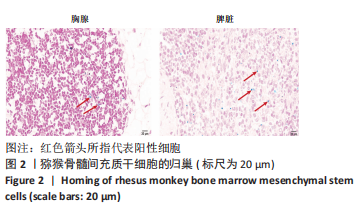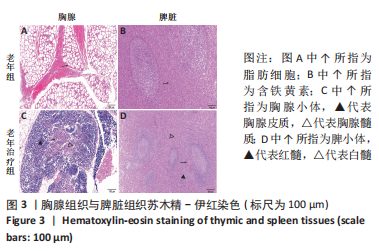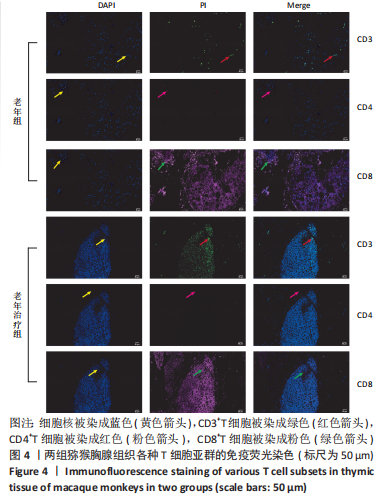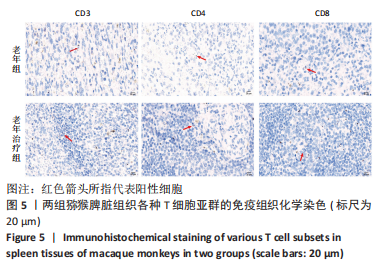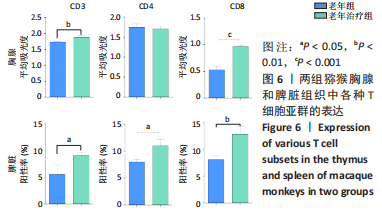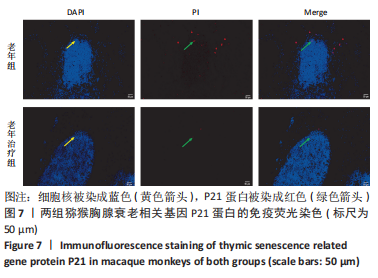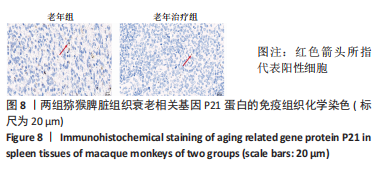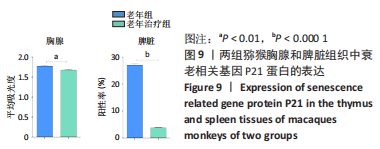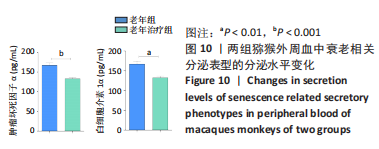中国组织工程研究 ›› 2023, Vol. 27 ›› Issue (19): 2953-2959.doi: 10.12307/2023.643
• 骨髓干细胞 bone marrow stem cells • 下一篇
骨髓间充质干细胞对衰老猕猴胸腺及脾脏结构和功能的影响
潘 杭1,2,朱向情2,何 洁2,杨再玲4,田 川2,吕冠柯5,阮光萍2,叶 丽1,2,何志旭6,舒莉萍3,潘兴华2
- 1贵州医科大学,组织工程与干细胞实验中心,贵州省贵阳市 550004;2中国人民解放军联勤保障部队第九二〇医院干细胞与免疫细胞生物医药技术国家地方联合工程实验室、云南省细胞治疗技术转化医学重点实验室、昆明市干细胞与再生医学重点实验室、基础医学实验室,云南省昆明市 650032;3贵州医科大学基础医学院免疫学教研室、细胞工程生物医药技术国家地方联合工程实验室、贵州省再生医学重点实验室、省部共建药用植物功效与利用国家重点实验室、中国医学科学院成体干细胞转化研究重点实验室,贵州省贵阳市 550004;4贵州医科大学附属医院肿瘤医院,贵州省贵阳市 550004;5四川省医学科学院、四川省人民医院,四川省成都市 610000;6遵义医科大学附属医院儿科学教研室,贵州省遵义市 563100
Effects of bone marrow mesenchymal stem cells on the structure and function of thymus and spleen in aging rhesus monkeys
Pan Hang1, 2, Zhu Xiangqing2, He jie2, Yang Zailing4, Tian Chuan2, Lyu Guanke5, Ruan Guangping2, Ye Li1, 2, He Zhixu6, Shu Liping3, Pan Xinghua2
- 1Tissue Engineering and Stem Cell Experimental Center, Guizhou Medical University, Guiyang 550004, Guizhou Province, China; 2Stem Cells and Immune Cells Biomedical Techniques Integrated Engineering Laboratory of State and Regions, Cell Therapy Technology Transfer Medical Key Laboratory of Yunnan Province, Kunming Key Laboratory of Stem Cell and Regenerative Medicine, Basic Medical Laboratory, 920 Hospital of Joint Logistics Support Force of Chinese PLA, Kunming 650032, Yunnan Province, China;3Department of Immunology of School of Basic Medicine of Guizhou Medical University, National and Local Joint Engineering Laboratory of Cell Engineering Biomedical Technology, Key Laboratory of Regenerative Medicine of Guizhou Province, State Key Laboratory of Efficacy and Utilization of Medicinal Plants Co-constructed by Province and Ministry, Key Laboratory of Translational Research of Adult Stem Cell of Chinese Academy of Medical Sciences, Guiyang 550004, Guizhou Province, China; 4Tumor Hospital, Affiliated Hospital of Guizhou Medical University, Guiyang 550004, Guizhou Province, China; 5Sichuan Academy of Medical Sciences, Sichuan Provincial People’s Hospital, Chengdu 610000, Sichuan Province, China; 6Department of Pediatrics, Affiliated Hospital of Zunyi Medical University, Zunyi 563100, Guizhou Province, China
摘要:
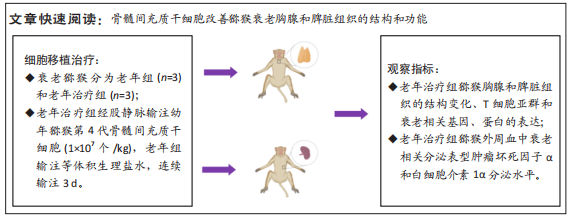
文题释义:
免疫衰老:随着年龄的增长,机体发生免疫系统功能障碍的过程,导致老年人口感染、癌症和自身免疫性疾病的发生率增加。衰老相关分泌表型:随着年龄增长,机体发生衰老,细胞也会发生功能丧失,细胞衰老通过分泌高水平的炎症细胞因子、趋化因子、生长因子以及金属蛋白酶来影响邻近细胞,从而引起慢性炎症。
背景:随着年龄的增长,脾脏的结构和功能发生改变,胸腺在青春期之后逐渐萎缩退化,导致机体发生免疫功能障碍。
目的:探讨骨髓间充质干细胞对衰老猕猴胸腺及脾脏结构和功能的作用。
方法:筛选出平均年龄25岁老年猕猴6只,随机分为老年组和老年治疗组各3只;老年治疗组猕猴经股静脉输注超顺磁性铁纳米颗粒标记的第4代骨髓间充质干细胞(1×107个/kg),1次/d,连续输注3 d,老年组猕猴在同一时间输注等体积的生理盐水;猕猴最后一次输注骨髓间充质干细胞5个月后给予安乐死处理,取出胸腺以及脾脏组织;苏木精-伊红染色观察胸腺组织和脾脏组织的结构变化;免疫荧光染色分析胸腺组织中各种T细胞亚群以及衰老相关基因蛋白P21的表达量变化;免疫组织化学染色分析脾脏组织中各种T细胞亚群以及衰老相关基因蛋白P21的表达量变化;安乐死处理猕猴之前抽取各组猕猴股静脉血5 mL,运用酶联免疫分析外周血血清中衰老相关分泌表型肿瘤坏死因子α和白细胞介素1α的分泌水平。
结果与结论:①超顺磁性铁纳米颗粒标记的骨髓间充质干细胞经过股静脉输注入猕猴体内能够成功定植在衰老胸腺和脾脏组织中发挥作用;②骨髓间充质干细胞移植治疗后,衰老猕猴中胸腺部分组织出现清晰的皮质与髓质交界,脂肪细胞减少,出现胸腺小体,向正常的胸腺组织结构转变;衰老猕猴中脾脏组织出现清晰的红髓与白髓分界,脾小体的边缘多完整,且巨噬细胞减少,向正常的脾脏组织结构转变;③与老年组相比,老年治疗组衰老胸腺和脾脏组织中CD3+、CD4+以及CD8+T细胞的表达量呈现增高的趋势,老年治疗组衰老胸腺和脾脏组织中P21蛋白的表达量呈现显著下降趋势;④与老年组相比,老年治疗组外周血中衰老相关分泌表型肿瘤坏死因子α以及白细胞介素1α的分泌水平呈现显著下降趋势;⑤上述结果表明,通过骨髓间充质干细胞的移植治疗,能够改善老年猕猴胸腺及脾脏组织的结构和功能。
https://orcid.org/0000-0003-2231-9672 (潘杭)
中国组织工程研究杂志出版内容重点:干细胞;骨髓干细胞;造血干细胞;脂肪干细胞;肿瘤干细胞;胚胎干细胞;脐带脐血干细胞;干细胞诱导;干细胞分化;组织工程
中图分类号:

